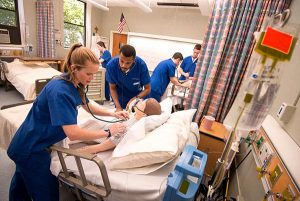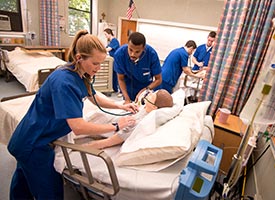By Paula Schlueter Ross
What goes up may not ever have to come down. Especially when you’re talking about 23 straight years of ever-escalating total enrollment at the Synod’s 10 Concordia University System (CUS) campuses nationwide.
This fall’s total CUS enrollment of 37,307 students (both graduate and undergraduate) includes an increase of 1,057 students, or 3 percent, over last year.

As in past years, most of that growth is due to an increase in total graduate enrollment: from 19,405 last year to 20,225 this year — an increase of 820, or 4 percent.
But combined undergraduate enrollment also grew slightly — this year’s 17,082 is an increase of 237 students, or 1 percent.
CUS President Rev. Dr. Dean O. Wenthe credits the institutions’ presidents: “This continued increase in enrollment underscores their capacity for leadership, imagination and execution because the current culture of higher education is very complicated and challenging.”
Combined CUS enrollment continues to climb, he said, even in the face of demographic studies that show the pool of college-age young people continuing to shrink. In 1999, Wenthe said, there were some 32,000 young people confirmed in the LCMS; “in 2014, we were down to about 19,000.”
But the CUS schools’ distinctive, faith-based education — founded on “the great solas of the Reformation: grace alone, faith alone, Scripture alone, Christ alone” — sets them apart from other universities, he said. That, along with their willingness to offer more and more graduate programs online and at satellite locations, as well as new programs that fill a need in their areas, have helped them not only weather the storm but see sunny days ahead.
The Rev. Dr. Paul A. Philp, director of Institutional Research and Integrity with the CUS, holds up the four-year-old School of Pharmacy at Concordia University Wisconsin, Mequon, as an example: “They identified a need within the state of Wisconsin where the number of pharmacy programs was very low,” Philp said. “There was a need to prepare pharmacists for local, small-town drugstores. So they found a niche that they could fill.” The school now is in the process of launching a nursing program at its Ann Arbor, Mich., campus.
Lessons from Bronxville
That idea is echoed by Dr. Viji D. George, 16-year president of Concordia College—New York, Bronxville, who points to the school’s “strategic program development” as one of the reasons it saw 11 percent enrollment growth over the past year.
Offering a baccalaureate nursing program and a graduate degree in special education are two recent additions that “have met a market need” locally, George told Reporter.
He also cites the “substantial growth” of the school’s international-student population. With the U.S. student pool drying up, Concordia, Bronxville, turned its attention overseas a few years ago and began recruiting students from China and India — where it established relationships with partner high schools and colleges, and opened its own admissions office in India. Today, those seeds are “bearing fruit just at the right time,” he says: The college’s student body now hails from 34 countries, and 14 percent of its students hold an international passport.
Another enrollment boost has been the college’s collaboration with Concordia University Portland and Concordia University, Nebraska, in Concordia Online Education as well as its partnership with local organizations to offer graduate education courses at a handful of off-site locations, including Brooklyn and Manhattan.
George offers this “key piece” of advice for increasing enrollment: Anticipate future trends and take action before they become reality.
“One thing that we’ve been good at,” he added, “is trying to figure out what’s coming around the bend and what should we be doing to address that?”
Church-work students
Just as total CUS enrollment climbs each year, the number of students enrolled in church-worker training programs at CUS schools continues to fall. There are 37 fewer church-work students this fall compared to 2014, for a total of 1,355.
Down are the number of students enrolled in programs for pre-seminary, 177 (by 13); teaching, 837 (30); director of Christian education, 207 (16); director of Christian outreach, 5 (5); and director of parish music, 17 (4).
Reflecting gains this fall are deaconess, 32 (up 7); lay ministry, 44 (7); and director of family life ministry, 36 (17), programs.
Wenthe admits that he and other Synod leaders are “very concerned” about the drop in church-work students, but adds that they are taking steps to address the problem.
“In the For the Sake of the Church program this year we’ll distribute [through CUS schools] about half a million dollars to help with tuition and support,” he said.
And, he added, LCMS President Rev. Dr. Matthew C. Harrison has convened a task force to address student debt, particularly among seminarians who may carry significant educational loans before they even enter the seminary. The average tuition at CUS schools is $25,881 per year.
The task force, chaired by LCMS Chief Mission Officer Rev. Kevin Robson, met for the first time in September, and includes representatives of the Synod’s two seminaries, the LCMS Office of the President, Lutheran Church Extension Fund, LCMS Foundation, Lutheran Federal Credit Union, Concordia Plan Services and Concordia Publishing House.
Robson told Reporter via email that he and other task force members “are seriously concerned that the current level of debt carried by many graduating seminarians (and other students going into professional church work), when combined with the probability of relatively low church-worker starting salaries, if left unaddressed, will provide a significant disincentive toward future enrollment in the Synod’s professional church-worker educational programs.
“It’s also safe to say that excessive debt has already curtailed individual student enrollments at both seminaries in certain cases, and is certainly damaging current student and church-worker overall well-being in others.”
Wenthe adds that congregational “tensions” today sometimes “make those careers not look so good.” In the past, “there was a lot of psychological reward” — church workers were respected and held in high esteem — and he encouraged the Synod to once again “support its workers with that kind of respect and emotional investment in their worth.”
Can it keep climbing?
With 23 years of nonstop growth, will CUS enrollment finally hit a ceiling one of these days?
Wenthe’s prayer is that, “under God’s grace,” CUS enrollment will keep growing in years to come, based on its Lutheran convictions. “That, as our culture becomes more secular, there will be parents who want their children to go to a school that has a view of what’s right and what’s inappropriate,” he said. “And that they want their students to think about the meaning of life and its significance, instead of just thinking about acquiring information to have a successful career, or acquire more.”
Said Wenthe: “I’d like to see us grow as classically Lutheran Christian institutions that stand out because we believe in the sanctity of life, the sanctity of marriage, and that human beings are God’s creatures and have been redeemed by God in Christ.”
And he added what he described as a “widespread assumption” held by many in the Synod, including himself: “That’s why our universities exist.”
Individual enrollments
This fall’s enrollments — including both graduate and undergraduate students — at individual CUS schools are as follows:
- Concordia University, Ann Arbor, Mich. — 900 (an increase of 71 students over fall 2014).
- Concordia University Texas, Austin — 2,570 (up 66).
- Concordia College—New York, Bronxville — 1,156 (up 119).
- Concordia University, Irvine, Calif. — 4,505 (up 194).
- Concordia University Wisconsin, Mequon — 8,268 (up 107).
- Concordia University Portland, Portland, Ore. — 7,182 (down 253).
- Concordia University Chicago, River Forest, Ill. — 5,238 (up 200).
- Concordia College Alabama, Selma — 651 (up 105).
- Concordia University, St. Paul, Minn. — 4,380 (up 323).
- Concordia University, Nebraska, Seward — 2,457 (up 125).
For more information about LCMS colleges and universities — and professional church-work careers — visit the website of the Concordia University System at lcms.org/cus.
A report on enrollment at the Synod’s two seminaries is planned for the January issue of Reporter.
Posted Dec. 1, 2015
